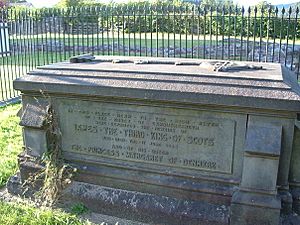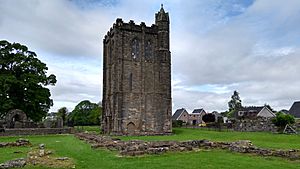Cambuskenneth Abbey facts for kids

The bell tower of Cambuskenneth Abbey
|
|
| Monastery information | |
|---|---|
| Other names | Abbey of St Mary of Stirling |
| Established | 1140 |
| Disestablished | 1560 |
| People | |
| Founder(s) | David I of Scotland |
| Abbot | David Arnot (1503–1509) Patrick Paniter (1513–1519) |
| Important associated figures | Robert the Bruce, Edward I |
Cambuskenneth Abbey was once an important monastery in Scotland. It was built by Augustinian monks. The abbey is located on a bend of the River Forth near Stirling. Today, most of the abbey is in ruins. However, its tall bell tower still stands. The nearby village of Cambuskenneth gets its name from the abbey.
Contents
History of Cambuskenneth Abbey
How the Abbey Started
Cambuskenneth Abbey was founded around the year 1140. It was built by order of King David I of Scotland. The monks who lived here were part of the Arrouaise Order from France. This was the only abbey of its kind in Scotland. These monks were known for their strict way of life.
The abbey was first called the Abbey of St Mary of Stirling. It was dedicated to the Virgin Mary. Sometimes, people just called it Stirling Abbey. Important leaders like Pope Eugene III protected the abbey. This protection was confirmed by other Popes later on. Around 1207, the abbey started to be known as Cambuskenneth.
Cambuskenneth was one of the most important abbeys in Scotland. This was partly because it was close to Stirling, a major town and sometimes the capital. King David I built many abbeys, including Cambuskenneth. These abbeys helped bring educated people to the royal court. They also helped with important government tasks.
Royal Connections: Robert the Bruce and Kings
Cambuskenneth Abbey was a royal abbey. It was like Holyrood Abbey in Edinburgh. Many important events happened here. In 1303, Edward I of England visited the abbey. He prayed there and received a promise of loyalty from a bishop.
In 1308, Scottish nobles promised their loyalty to Robert the Bruce at the abbey. The abbey's connection to Robert the Bruce continued. In 1314, a parliament was held there. This was five months after the Scottish victory at the Battle of Bannockburn. The treasures from the battle were even shared out at the abbey.
In 1326, another parliament took place. Nobles and church leaders promised loyalty to King Robert. They also confirmed that his son, David II, would be the next king. The abbey was used so often for parliaments that one building was called "Parliament Hall."
The abbey stayed close to Robert the Bruce's family. Robert II signed important documents there in 1380. He also stayed at the abbey for several days. His son, Robert III, also conducted royal business there in 1392.
Royal Burials at the Abbey

In 1486, Margaret of Denmark died at Stirling Castle. She was the Queen of Scotland. She was buried at Cambuskenneth Abbey. In 1488, her husband, James III, was killed. This happened at the Battle of Sauchieburn. His body was brought to Cambuskenneth Abbey for burial.
His tomb was finished in 1502. It was painted by an artist named David Pratt. Over time, the tomb was damaged. But it was restored in 1865. Queen Victoria paid for this restoration. Today, the tomb stands in a fenced area at the east end of the abbey ruins.
Later Years and Closure
Patrick Paniter became the Abbot of Cambuskenneth in 1513. He was a very important person. He was also a secretary to James V. He even fought in the Battle of Flodden in the same year.
The abbey stopped being used during the Scottish Reformation. This was a time of big changes in Scotland's religion. In 1560, the abbey was put under the control of the military governor of Stirling Castle. This was John Erskine. He had much of the abbey's stone removed. This stone was then used to build parts of Stirling Castle. His nephew, Adam Erskine, then took charge of the abbey's remaining property.
Abbey Craig, where the Wallace Monument stands, is named because it is close to Cambuskenneth Abbey.
Cambuskenneth Abbey Today
The abbey became property of the Crown in 1908. Today, Historic Scotland looks after it. The abbey is open for visitors during the summer months. You can see the foundations of the abbey church and other buildings. Most of these date back to the 13th century.
Only the 13th-century campanile (bell tower) is still complete. It was repaired in 1859. There is also an old graveyard on the site. This graveyard includes the tomb of James III of Scotland and his wife, Margaret of Denmark. Many of the Abbots of Cambuskenneth are also buried there.
See also



